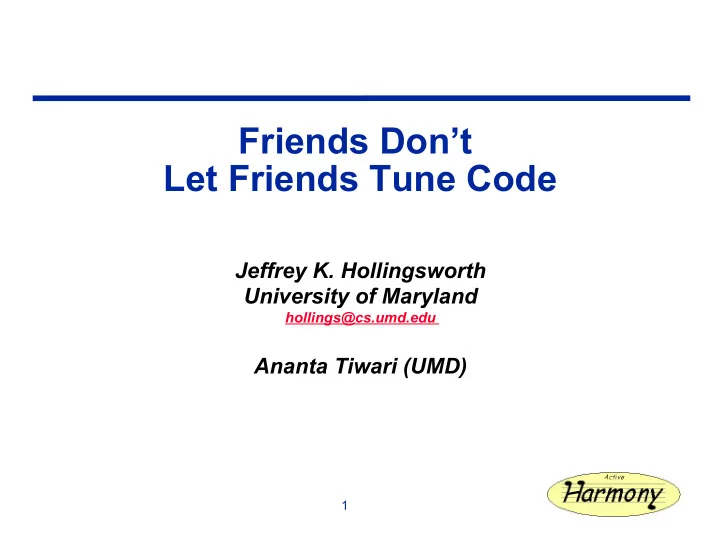

Friends Don’t Let Friends Tune Code Jeffrey K. Hollingsworth University of Maryland hollings@cs.umd.edu Ananta Tiwari (UMD) 1
About the Title 2
Why Automate Performance Tuning? Too many parameters that impact performance. Optimal performance for a given system depends on: Details of the processor Details of the inputs (workload) Which nodes are assigned to the program Other things running on the system Parameters come from: User code Libraries Compiler choices Automated Parameter tuning can be used for adaptive tuning in complex software. 3
Automated Performance Tuning Goal: Maximize achieved performance Problems: Large number of parameters to tune Shape of objective function unknown Multiple libraries and coupled applications Analytical model may not be available Requirements: Runtime tuning for long running programs Don’t try too many configurations Avoid gradients 4
Active Harmony Runtime performance optimization Can also support training runs Automatic library selection (code) Monitor library performance Switch library if necessary Automatic performance tuning (parameter) Monitor system performance Adjust runtime parameters Hooks for Compiler Frameworks Working to integrate USC/ISI Chill Looking at others too 5
Parallel Rank Ordering Algorithm All, but the best point of simplex moves. Computations can be done in parallel. 6
Application Parameter Tuning: GS2 Physics application (DOE SciDAC project) Developed to study low-frequency turbulence in magnetized plasma Performance (execution time) improvement by changing layout and three parameters (negrid, ntheta, nodes) Data layout analysis 120 Execution time (seconds) 100 (benchmarking runs) 80 55.06s → 16.25s 60 (3.4x faster, W/O collision) 40 71.08s → 31.55s 20 0 (2.3x faster, W collision) lexys lxyes lyxes yxels yxles Data layout Linux 64x2 Seaborg 16x8 Seaborg 8x16 Seaborg 13x10 7
Tool Integration: CHiLL + Active Harmony Generate and evaluate different optimizations that would have been prohibitively time consuming for a programmer to explore manually. Ananta Tiwari, Chun Chen, Jacqueline Chame, Mary Hall, Jeffrey K. Hollingsworth, “A Scalable Auto-tuning Framework for Compiler Optimization,” IPDPS 2009, Rome, May 2009. 8
SMG2000 Optimization Outlined Code for (si = 0; si < stencil_size; si++) for (kk = 0; kk < hypre__mz; kk++) for (jj = 0; jj < hypre__my; jj++) for (ii = 0; ii < hypre__mx; ii++) rp[((ri+ii)+(jj*hypre__sy3))+(kk*hypre__sz3)] -= ((Ap_0[((ii+(jj*hypre__sy1))+ (kk*hypre__sz1))+ (((A->data_indices)[i])[si])])* (xp_0[((ii+(jj*hypre__sy2))+(kk*hypre__sz2))+(( *dxp_s)[si])])); CHiLL Transformation Recipe Constraints on Search permute([2,3,1,4]) 0 ≤ TI , TJ, TK ≤ 122 tile(0,4,TI) 0 ≤ UI ≤ 16 tile(0,3,TJ) 0 ≤ US ≤ 10 tile(0,3,TK) compilers ∈ {gcc, icc} unroll(0,6,US) Search space: unroll(0,7,UI) 122 3 x16x10x2 = 581M points 9
SMG2000 Search and Results Parallel search evaluates 490 points and converges in 20 steps Selected parameters: TI=122,TJ=106,TK=56,UI=8,US=3,Comp=gcc Performance gain on residual computation: 2.37X Performance gain on full app: 27.23% improvement 10
Auto Tuning For Different Platforms Fixed parameters: Code: PMLB Processors: 64 Study how parameters differ for the two systems Use harmony determined parameters from one system Run a post-line (fix parameters for entire run) run on another Speedup (post-line) run Speedup (post-line) run on UMD Cluster on Carver Cluster Problem UMD Best Carver Best Carver Best UMD Best Size Config Config Config Config 384 3 1.44 1.19 1.32 1.30 448 3 1.42 1.13 1.51 1.38 512 3 1.30 1.26 1.34 1.30 576 3 1.38 1.16 1.42 1.39 11
Autotuning PFloTran (Trisolve) Outlined Code CHiLL Transformation Recipe #define SIZE 15 original() void forward_solve_kernel( … ) { known(bs > 14) …. known(bs < 16) for (cntr = SIZE - 1; cntr >= 0; cntr--) { unroll(1,2,u1) x[cntr] = t + bs * (*vi ++); unroll(1,3,u2) for (j=0; j<bs; j++) for (k=0; k<bs; k++) s[k]-= v[cntr][bs* j+k] * x[cntr][j]; } } Search space: Constraints on Search 0 <= u1 <= 16 17x17x4 = 1156 points 0 <= u2 <= 16 compilers ∈ {gnu, pathscale, cray, pgi} 12
PFloTran: Trisolve Results Compiler Original Active Harmony Exhaustive Time Time (u1,u2) Speedup Time (u1,u2) Speedup pathscale 0.58 0.32 (3,11) 1.81 0.30 (3,15) 1.93 gnu 0.71 0.47 (5,13) 1.51 0.46 (5,7) 1.54 pgi 0.90 0.53 (5,3) 1.70 0.53 (5,3) 1.70 cray 1.13 0.70 (15,5) 1.61 0.69 (15,15) 1.63 13
Compiling New Code Variants at Runtime PM 1 , PM 2 , … PM N Search Steps (SS) Harmony Timeline Active Harmony Outlined Code Transformation Parameters code-section SS 1 SS 2 SS N Code Server Code Generation Tools v 1 s v 2 s v N s compiler compiler compiler READY Signal Application Application Execution timeline v N s.so v 1 s.so v 2 s.so stall_phase Performance PM 2 Measurements PM N PM 1 (PM) 14
Online Code Generation Results Two platforms umd-cluster (64 nodes, Intel Xeon dual-core nodes) – myrinet interconnect Carver (1120 compute nodes, Intel Nehalem. two quad core processors) – infiniband interconnect Code servers UMD-cluster – local idle machines Carver – outsourced to a machine at umd Codes Poisson Solver PMLB Parallel Multi-block Lattice Boltzman SMG2000 15 15
How Many Nodes to Generate Code? Fixed parameters: Code: poission solver problem-size (1024 3 ) number of processors (128) Up to 128 new variants are generated at each search step Code Servers Search Step Stalled steps + Variations Speedup + s + evaluated + 1 6* 46 502 0.75 2 17* 13 710 0.97 4 27 7.2 928 1.04 8 23 4.5 818 1.23 12 22 4.1 833 1.21 16 26 3.6 931 1.24 * Search did not complete before application terminated + Mean of 5 runs 16
Conclusions and Future Work Ongoing Work More end-to-end Application Studies Continued Evaluation of Online Code Generation Conclusions Auto tuning can be done at many levels Offline – using training runs (choices fixed for an entire run) Compiler options Programmer supplied per-run tunable parameters Compiler Transformations Online –training or production (choices change during execution) Programmer supplied per-timestep parameters Compiler Transformations It Works! Real programs run faster 17
Recommend
More recommend